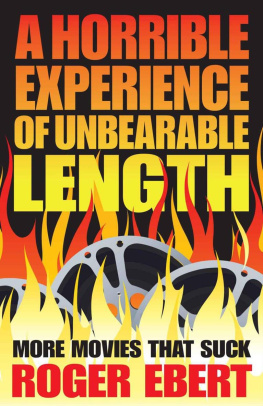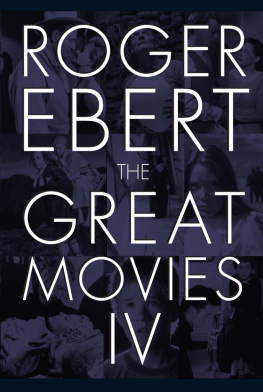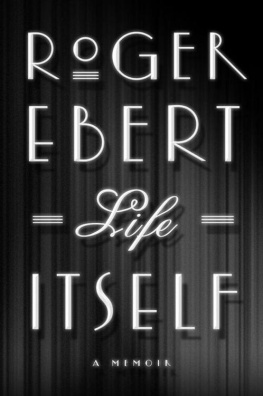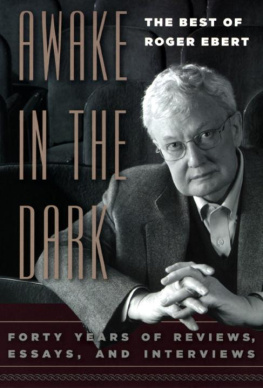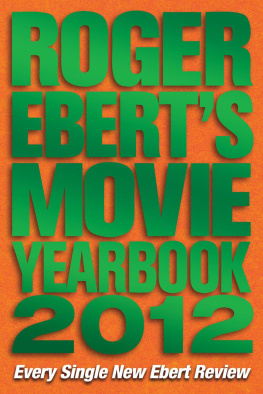

THE
{ G REAT M OVIES }
R OGER E BERT
Photo Stills Selected by Mary Corliss,
Assistant Film Curator, Museum of Modern Art
Broadway Books
New York
CONTENTS
T his book is dedicated to
Daniel Curley
Manny Farber
Pauline Kael
Stanley Kauffmann
Arthur Knight
Dwight Macdonald
Donald Richie
Andrew Sarris
Teachers
INTRODUCTION
W e live in a box of space and time. Movies are windows in its walls. They allow us to enter other mindsnot simply in the sense of identifying with the characters, although that is an important part of it, but by seeing the world as another person sees it. Franois Truffaut said that for a director it was an inspiring sight to walk to the front of a movie theater, turn around, and look back at the faces of the audience, turned up to the light from the screen. If the film is any good, those faces reflect an out-of-the-body experience: The audience for a brief time is somewhere else, sometime else, concerned with lives that are not its own. Of all the arts, movies are the most powerful aid to empathy, and good ones make us into better people.
Not many of them are very good, however. Yes, there are the passable Friday night specials, measured by critics including myself in terms of their value in entertaining us for two hours. We buy our tickets and hope for diversion, and usually we get it, but we so rarely get anything more. Especially in these latter days of the marketing-driven Hollywood, and a world cinema dominated by the Hollywood machine, films aim coarsely at low tastes. If you put three thoughts into a movie youve broken the law and no one will come, Sean Penn told an audience at the Edinburgh Festival in 2001. The movies in this book have three thoughts, or more. They are not the 100 greatest films of all time, because all lists of great movies are a foolish attempt to codify works which must stand alone. But its fair to say: If you want to make a tour of the landmarks of the first century of cinema, start here.
I began writing these essays at a time when new Hollywood product seemed at a low ebb (it has ebbed lower) and many younger filmgoers seemed to have little sense of the cinemas past. Every spring since 1968 I have attended the Conference on World Affairs at the University of Colorado in Boulder, and conducted a week-long exploration of one film. We sit in the dark and use stop-action to creep through a film, sometimes at a shot-by-shot pace. At first we used 16mm; then laserdiscs and DVD made it easier. Everybody engages in the discussion. It is democracy in the dark, with an image frozen on the screen. In earlier years I did mostly classics (Citizen Kane, The Third Man, La Dolce Vita, The General, Notorious, Persona, Ikiru, Taxi Driver). In recent years, reflecting the death of film societies and the rise of home video, the students were less interested in the past. One year I suggested Vertigo and they begged me to do Fight Club.
We did both. Fight Club was not a film I approved of, although I recognized its skill and knew from countless e-mails how strong an impression it made on its admirers. Seeing it over the course of a week, I admired its skill even more, and its thought even less. It lacks an intelligent drawing-together of its themes, but that is not held against it in a time when audiences are assaulted with sound and motion, when shots get shorter and movies get louder, when special effects replace or upstage theme and performance. The ability of an audience to enter into the narrative arc of a movie is being lost; do todays audiences have the patience to wait for Harry Lime in The Third Man?
At Boulder and on other campuses, talking with the students, I found that certain names were no longer recognized. Even students majoring in film had never seen one by Buuel, Bresson, or Ozu. Theyd seen one or two titles by Ford and Wilder, knew a half-dozen Hitchcock classics, genuflected at Citizen Kane, knew the Star Wars pictures by heart, and sometimes uttered those words which marked them as irredeemably philistine: I dont like black and white. Sixty of these films are in black and white, and three use b&w and color; you cannot know the history of the movies, or love them, unless you understand why b&w can give more, not less, than color.
I came to believe that the classics of earlier years were an unexplored country for many filmgoers, even the best ones. As a film critic for a daily newspaper, I didnt want to spend my life locked in the present. In 1997 I went to Nigel Wade, then the editor of the Chicago Sun-Times, and proposed a biweekly series of longer articles revisiting the great movies of the past. He gave his blessing. Not many editors would have; the emphasis in American film journalism is on celebrity news, box office results, and other forms of bottom-feeding. Every other week since then, I have revisited a great movie, and the response has been encouraging. I received letters and e-mails from movie lovers; got into debates with other critics; heard from a university trustee and a teenager in Madison who both vowed to watch every movie on the list. The Library Media Project made discounted DVDs of the movies available to public libraries.
The relative invisibility of classic movies is directly related to the death of film societies. Until the rise of home video, every campus and many public libraries and community centers had film societies which held cheap and well-programmed 16mm screenings. My early film initiation took place at two such clubs at the University of Illinois, which also inspired me to see first-run films I might otherwise have avoided. I saw Ikiru, The 400 Blows, The Maltese Falcon, and Swing Time for the first time in those campus roomsknowing little or nothing about them except that they cost only twenty-five cents, and that afterward people got together in the student union and drank coffee and talked about them.
In theory home video should be a godsend for lovers of great films, and indeed most of these titles are available on video in one form or another, and that is how most people will have to see them. But when you enter the neighborhood video chain store, display boxes near the door push the latest new on video Hollywood blockbusters, and you have to prowl in the shadows to find foreign films and classicsoften a pitiful selection. Independent local video stores and Web-based operations like netflix.com and facets.org give access to a much larger range of films, but does the average moviegoer ever find them? In the 1960s Stanley Kauffmann coined the term the film generation to describe the phenomenon of younger filmgoers who were film-obsessed. I was a member of that generation, and can personally testify that I waited in line at ordinary theaters to get into sold-out performances of Resnaiss Last Year at Marienbad and Godards Weekend. Today even the most popular subtitled films are ignored by the national distribution oligarchy, mainstream movies are pitched at the teenage male demographic group, and the lines outside theaters are for Hollywoods new specialty, B movies with A budgets.
Ive seen some of the movies in this book dozens of times, and have been through forty-seven of them a shot at a time. But I made a fresh viewing before writing each essay; that was the whole idea. I was reminded of a similar selection by the British critic Derek Malcolm, who said his list simply reflected films he could not bear the thought of never seeing again. I have revised and lengthened these pieces for book publication, and made adjustments where necessaryfor example, discussing the new longer version of
Next page


